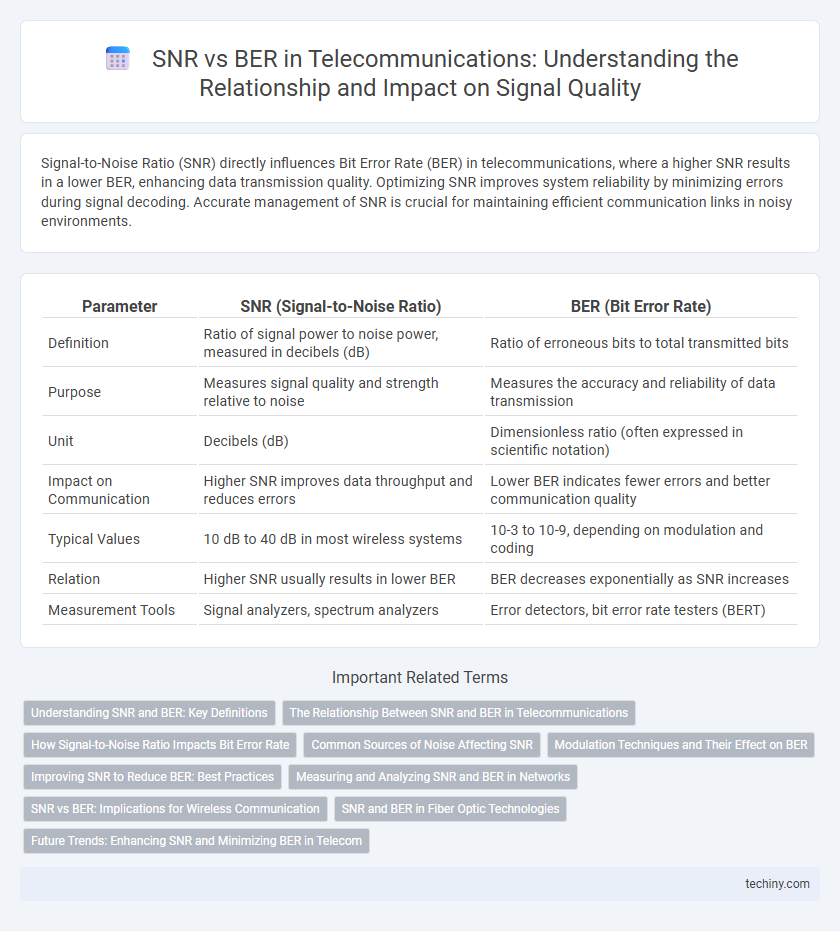Signal-to-Noise Ratio (SNR) directly influences Bit Error Rate (BER) in telecommunications, where a higher SNR results in a lower BER, enhancing data transmission quality. Optimizing SNR improves system reliability by minimizing errors during signal decoding. Accurate management of SNR is crucial for maintaining efficient communication links in noisy environments.
Table of Comparison
| Parameter | SNR (Signal-to-Noise Ratio) | BER (Bit Error Rate) |
|---|---|---|
| Definition | Ratio of signal power to noise power, measured in decibels (dB) | Ratio of erroneous bits to total transmitted bits |
| Purpose | Measures signal quality and strength relative to noise | Measures the accuracy and reliability of data transmission |
| Unit | Decibels (dB) | Dimensionless ratio (often expressed in scientific notation) |
| Impact on Communication | Higher SNR improves data throughput and reduces errors | Lower BER indicates fewer errors and better communication quality |
| Typical Values | 10 dB to 40 dB in most wireless systems | 10-3 to 10-9, depending on modulation and coding |
| Relation | Higher SNR usually results in lower BER | BER decreases exponentially as SNR increases |
| Measurement Tools | Signal analyzers, spectrum analyzers | Error detectors, bit error rate testers (BERT) |
Understanding SNR and BER: Key Definitions
Signal-to-Noise Ratio (SNR) measures the strength of the desired signal relative to background noise, expressed in decibels (dB), and is crucial for evaluating communication quality. Bit Error Rate (BER) quantifies the number of bit errors divided by the total transmitted bits during a given time interval, serving as a key performance indicator of data integrity in digital transmissions. Understanding the relationship between high SNR values and low BER is essential for optimizing telecommunications systems and ensuring reliable data transfer.
The Relationship Between SNR and BER in Telecommunications
Signal-to-Noise Ratio (SNR) directly influences Bit Error Rate (BER) in telecommunications by determining the clarity of the transmitted signal over noise interference. Higher SNR values contribute to lower BER, resulting in improved data integrity and communication quality. Understanding this relationship is critical for optimizing wireless network performance and minimizing data loss in digital transmission systems.
How Signal-to-Noise Ratio Impacts Bit Error Rate
Signal-to-Noise Ratio (SNR) directly affects the Bit Error Rate (BER) in telecommunications by determining the clarity of the received signal amidst noise interference. Higher SNR values signify clearer signals, resulting in lower BER and thus improved data transmission reliability. As SNR decreases, noise dominates the signal, causing an increase in BER and degrading communication quality.
Common Sources of Noise Affecting SNR
Common sources of noise affecting Signal-to-Noise Ratio (SNR) in telecommunications include thermal noise generated by electronic components, intermodulation noise caused by nonlinearities in amplifiers, and crosstalk resulting from electromagnetic interference between adjacent communication channels. Atmospheric noise, such as lightning and solar radiation, further degrades SNR by introducing random fluctuations in signal strength. Understanding these noise sources is essential for improving Bit Error Rate (BER) performance, as higher noise levels directly correlate with increased error rates in digital transmissions.
Modulation Techniques and Their Effect on BER
Modulation techniques such as QPSK, QAM, and PSK directly influence the relationship between Signal-to-Noise Ratio (SNR) and Bit Error Rate (BER) in telecommunications. Higher-order modulation schemes increase spectral efficiency but require a higher SNR to maintain low BER due to their sensitivity to noise and interference. Adaptive modulation dynamically adjusts the constellation size based on channel conditions, optimizing BER performance by balancing data rate and signal robustness.
Improving SNR to Reduce BER: Best Practices
Improving Signal-to-Noise Ratio (SNR) directly enhances the Bit Error Rate (BER) performance in telecommunications by minimizing noise impact and ensuring clearer signal transmission. Techniques such as using high-quality antennas, implementing advanced error-correcting codes, and optimizing modulation schemes significantly boost SNR, resulting in lower BER and more reliable data communication. Regular maintenance of equipment and minimizing interference through proper frequency planning further contribute to maximizing SNR and reducing transmission errors.
Measuring and Analyzing SNR and BER in Networks
Measuring Signal-to-Noise Ratio (SNR) and Bit Error Rate (BER) in telecommunications networks involves using specialized test equipment like spectrum analyzers and BER testers to evaluate signal integrity and transmission quality. High SNR values indicate strong signal presence relative to background noise, directly influencing lower BER, which quantifies the frequency of bit errors in the received data stream. Accurate analysis of SNR and BER metrics enables network engineers to diagnose issues, optimize system performance, and ensure reliable data communication across various network infrastructures.
SNR vs BER: Implications for Wireless Communication
Signal-to-Noise Ratio (SNR) directly impacts Bit Error Rate (BER) in wireless communication, as a higher SNR typically results in a lower BER and improved data integrity. Optimizing SNR through advanced modulation schemes and error correction techniques enhances overall network performance and reliability. Maintaining an optimal SNR is critical for minimizing transmission errors and ensuring efficient spectrum utilization in wireless systems.
SNR and BER in Fiber Optic Technologies
In fiber optic technologies, the Signal-to-Noise Ratio (SNR) plays a critical role in determining the Bit Error Rate (BER), directly impacting data transmission quality and system reliability. High SNR values indicate strong signal power relative to noise, resulting in lower BER and improved error performance in optical communication links. Optimizing SNR through advanced modulation techniques and noise reduction methods enhances the effectiveness of fiber optic networks in delivering high-speed, error-free data transfer.
Future Trends: Enhancing SNR and Minimizing BER in Telecom
Emerging technologies in telecommunications leverage advanced modulation techniques and adaptive coding to significantly enhance Signal-to-Noise Ratio (SNR) and minimize Bit Error Rate (BER), driving more reliable data transmission. Machine learning algorithms optimize channel estimation and noise reduction processes, enabling real-time adjustments that improve SNR and reduce BER under varying network conditions. Future trends also include the integration of quantum communication and massive MIMO systems, promising substantial improvements in SNR and ultra-low BER for next-generation 6G networks.
SNR vs BER Infographic

 techiny.com
techiny.com